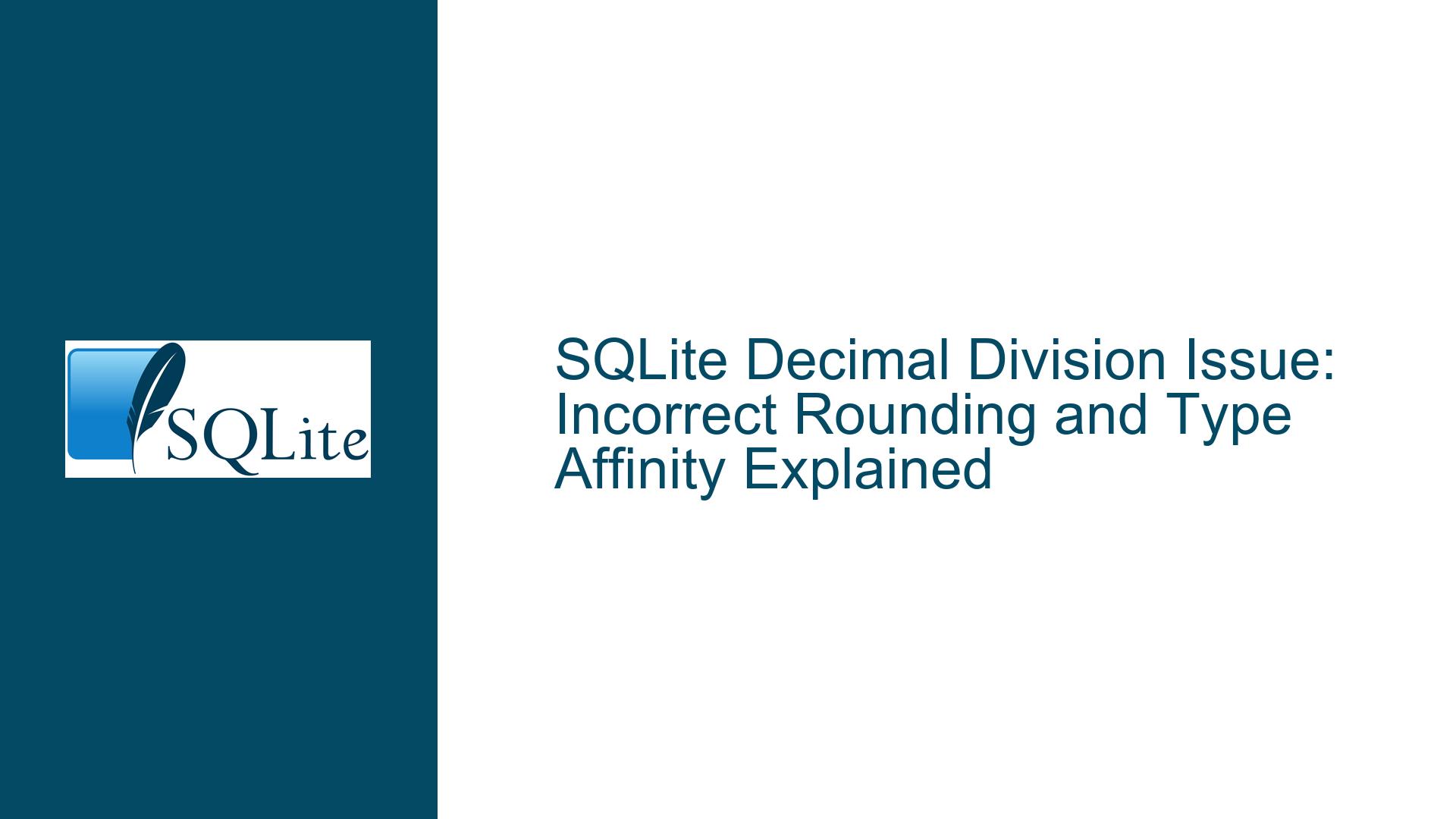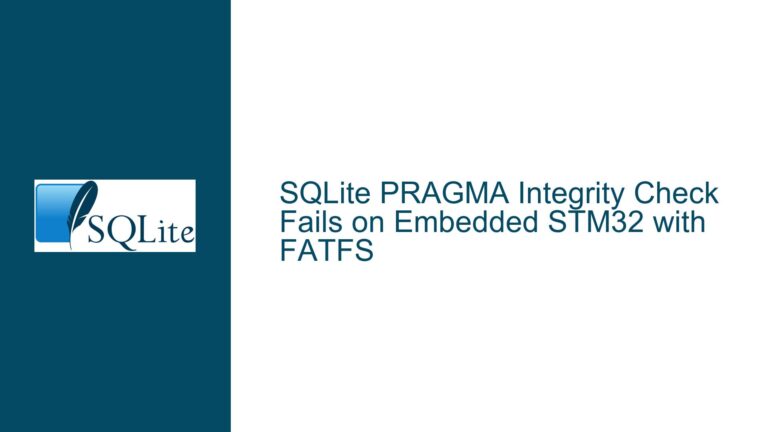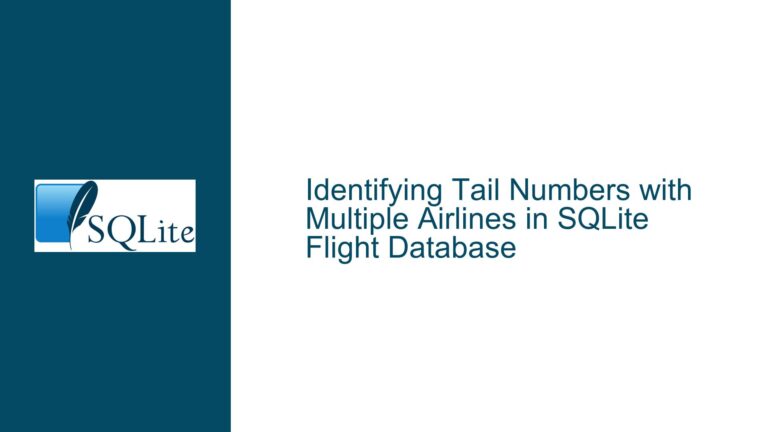SQLite Decimal Division Issue: Incorrect Rounding and Type Affinity Explained
Issue Overview: Decimal Division Yields Rounded Integer Results
In SQLite, when performing division operations involving columns declared as DECIMAL, the results may unexpectedly round to integers instead of returning floating-point values. This behavior is particularly noticeable when dividing two decimal values that do not have a fractional component. For example, dividing 20 by 30 yields 0 instead of the expected 0.666666666666667. This issue arises due to SQLite’s dynamic typing system and its handling of type affinities, which differ from other database systems like PostgreSQL or MySQL.
The schema in question defines several columns as DECIMAL, such as price and original_price. When performing a division operation like price / original_price, SQLite does not automatically treat the result as a floating-point number unless explicitly instructed to do so. This behavior is rooted in SQLite’s type affinity rules, where DECIMAL is treated as NUMERIC, and numeric values are stored as integers when possible. Consequently, the division operation defaults to integer division, truncating any fractional component.
The issue becomes more apparent when comparing the results of division operations with and without explicit type casting. For instance, casting one of the operands to REAL (e.g., CAST(price AS REAL)) ensures that the division operation returns a floating-point result. However, this workaround is not always practical, especially when working with frameworks like Django that abstract database operations and assume consistent behavior across different database backends.
Possible Causes: Type Affinity and Dynamic Typing in SQLite
The root cause of this issue lies in SQLite’s type affinity system and its dynamic typing behavior. Unlike other databases, SQLite does not enforce strict column types. Instead, it uses type affinity to determine how values are stored and processed. When a column is declared as DECIMAL, SQLite maps it to the NUMERIC affinity, which prefers integer storage for values that can be represented as integers. This mapping is governed by the following rules:
Type Affinity Rules: SQLite’s type affinity system maps common type names (e.g.,
DECIMAL,NUMERIC,INTEGER) to one of five affinities:TEXT,NUMERIC,INTEGER,REAL, orBLOB. TheDECIMALtype name resolves toNUMERICaffinity, which prefers integer storage when possible.Dynamic Typing: SQLite stores values in a flexible format that adapts to the data being stored. If a value can be represented as an integer, SQLite stores it as an integer, even if the column is declared as
DECIMALorNUMERIC. This behavior is efficient for storage but can lead to unexpected results in arithmetic operations.Division Behavior: In SQLite, the result of a division operation depends on the storage format of the operands. If both operands are stored as integers, the division defaults to integer division, truncating any fractional component. This behavior is consistent with SQLite’s goal of minimizing storage overhead but can be counterintuitive for users expecting floating-point results.
Framework Assumptions: Frameworks like Django often assume consistent behavior across database backends. When a
DecimalFieldis used in Django, it maps toDECIMALin SQLite, expecting floating-point behavior. However, due to SQLite’s type affinity rules, this assumption does not hold, leading to discrepancies between development (using SQLite) and production (using PostgreSQL or MySQL) environments.
Troubleshooting Steps, Solutions & Fixes
To address the issue of incorrect rounding in decimal division operations, several approaches can be taken, depending on the specific use case and constraints. Below are detailed steps and solutions to ensure accurate division results in SQLite:
1. Explicit Type Casting to REAL
The most straightforward solution is to explicitly cast one or both operands to REAL before performing the division. This ensures that the operation is treated as floating-point division, preserving the fractional component of the result. For example:
SELECT price, original_price, CAST(price AS REAL) / original_price FROM product_product;
This approach works well for ad-hoc queries but may not be practical in all scenarios, especially when using ORMs like Django that abstract away raw SQL.
2. Using Multiplication to Force Floating-Point Division
Another workaround is to multiply one of the operands by 1.0 to force floating-point division. This technique leverages SQLite’s dynamic typing to implicitly convert the result to a floating-point number. For example:
SELECT price, original_price, (price * 1.0) / original_price FROM product_product;
This method is effective and does not require explicit type casting, making it suitable for use in frameworks that generate SQL queries.
3. Adjusting Django’s DecimalField Mapping
For Django users, the issue can be addressed by modifying how DecimalField maps to SQLite’s column types. Currently, Django maps DecimalField to DECIMAL, which resolves to NUMERIC affinity in SQLite. To ensure floating-point behavior, consider using a custom field that maps to REAL instead. This can be achieved by subclassing DecimalField and overriding its database type:
from django.db import models
class RealDecimalField(models.DecimalField):
def db_type(self, connection):
if connection.vendor == 'sqlite':
return 'REAL'
return super().db_type(connection)
This custom field ensures that REAL is used for SQLite while maintaining DECIMAL for other databases. However, this approach requires careful testing to avoid unintended side effects.
4. Using SQLite’s Decimal Extension
SQLite provides a decimal extension that implements arbitrary-precision decimal arithmetic. This extension can be used to ensure accurate decimal division without relying on floating-point numbers. To use the extension, load it into your SQLite session and perform calculations using the decimal function:
SELECT price, original_price, decimal(price) / decimal(original_price) FROM product_product;
This approach is ideal for applications requiring high precision but may not be supported by all frameworks or environments.
5. Storing Values as Integers
For applications involving monetary values, consider storing values as integers representing the smallest unit (e.g., cents) and converting to the desired unit (e.g., dollars) in application code. This approach avoids floating-point arithmetic altogether and ensures precise calculations. For example:
CREATE TABLE product_product (
price INTEGER, -- Price in cents
original_price INTEGER -- Original price in cents
);
SELECT price, original_price, (price * 1.0) / original_price FROM product_product;
This method is particularly useful for financial applications where precision is critical.
6. Framework-Specific Workarounds
For Django users, consider using framework-specific workarounds to ensure consistent behavior across database backends. For example, you can use Django’s F expressions and Value wrappers to force floating-point division:
from django.db.models import F, Value
T.objects.annotate(
foo=(Value(Decimal("1.0")) * F("price")) / F("original_price"),
)
This approach ensures that the division operation is performed as floating-point arithmetic, regardless of the underlying database.
7. Documentation and Awareness
Finally, ensure that your team is aware of SQLite’s type affinity rules and their implications for arithmetic operations. Document any workarounds or customizations to avoid confusion and ensure consistent behavior across development and production environments.
By understanding SQLite’s type affinity system and applying the appropriate workarounds, you can ensure accurate and consistent results in decimal division operations, even when working with frameworks that abstract database interactions.






